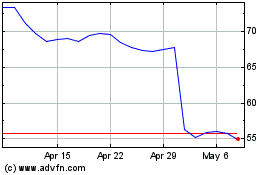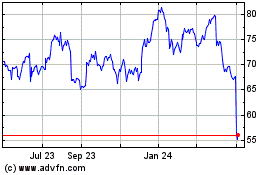Why Bond Investors Aren't Worried About Corporate America's Rising Debt Load
March 10 2018 - 7:30AM
Dow Jones News
By Daniel Kruger
U.S. corporate debt has climbed to levels that have coincided
with recent recessions. Many analysts and investors are
unconcerned.
Even before this week's blockbuster $40 billion bond sale by CVS
Health Corp., corporate debt stood at 45% of GDP, a level it last
reached in 2008 as the economy was entering a recession, according
to Moody's Investors Service.
Some companies with weaker credit quality are finding it easier
to access the bond market, and others are skimping on covenants
protecting investors. Yet analysts say the differences between the
current period and 2008 and 2001 -- when corporate debt rose to
similar levels as the U.S. tipped toward contraction -- are more
important than any similarities.
Today, signs of economic growth persist, supported by corporate
tax cuts and a stimulative budget deal, as well as borrowing costs
that remain relatively low by historical standards. That means
companies can continue to borrow without creating significant
economic risks, according to analysts.
Moody's predicts the economy will grow 2.7% this year and
expects the default rate on corporate bonds to drop to 2.2% by
year-end from 3.2% in January.
Today's credit conditions are also stronger than in the past
because of larger capital buffers held by U.S. banks as part of
more stringent regulatory standards, Moody's analysts said.
Banks' bondholdings have shrunk drastically since the financial
crisis, in part because of Dodd-Frank banking reforms but also
because investors are more willing to buy the securities they
underwrite. This signals an improved capacity within the economy to
handle the present level of corporate borrowing.
Banks formerly held significant amounts of bonds either as
unsold inventory from or with their proprietary trading units. In
January 2008, the bond dealers in the Federal Reserve's network of
primary dealers who underwrite the U.S. Treasury debt held as much
as $279 billion of corporate debt on their balance sheets compared
with $24 billion as of last month.
Corporations are in a better position to function with higher
debt burdens than in the past, some analysts said.
"The difference this time is really in the debt affordability,"
said Anne van Praagh, head of credit strategy & research at
Moody's Investors Service.
The yield on the 10-year Treasury note, which serves as a
benchmark lending rate for companies, has climbed this year,
recently hitting a multiyear high of 2.943%, compared with an
average rate of 4.63% in 2007. And with credit spreads -- the
difference in yield between corporate bonds and Treasury debt --
hovering near multiyear lows, investor demand continues to hold
down borrowing costs for most companies.
The lower rates mean that interest payments represent a smaller
share of a given company's cash flow, said Peter Strzalkowski, a
bond portfolio manager at OppenheimerFunds Inc. Many companies have
taken advantage of low longer-term interest-rates to extend the
maturities of their debt and don't face an imminent need to repay
their loans, he said.
Not every observer is so sanguine about the rise in company debt
levels. Such a climb in the late stages of an expansion tends to
happen as companies become increasingly likely to pursue strategies
intended to boost their stock prices, such as share buybacks, or
growth that is no longer happening organically, such as through
mergers or acquisitions, said David Ader, chief macro strategist
for Informa Financial Intelligence.
Both buybacks and M&A activity are heating up. CVS sold
bonds Tuesday to help pay for its acquisition of health insurer
Aetna Inc. Qualcomm Inc. has also offered to buy NXP Semiconductors
for $44 billion in a deal which could be financed in part by bonds.
Other pending deals include United Technologies Corp.'s $23 billion
planned purchase of Rockwell Collins and Bayer AG's $57 billion
expected acquisition of Monsanto Co.
Yet companies appear to be dodging the most-obvious pitfalls, by
doing things like extending their repayment dates, some analysts
said.
A rise in outstanding corporate debt late in an expansion tends
to coincide with periods of Fed rate increases. Under those
conditions, companies with large short-term debts have to refinance
when borrowing costs are rising, said Steven Ricchiuto, chief
economist at Mizuho Securities USA. As company cash flows get
diverted to higher interest payments, less of it becomes available
for wages and investment, curbing growth and inflation, he
said.
Rising interest costs also "squeezes profitability," leading to
slower wage growth, reduced business investment and layoffs, he
said. So far for this expansion, "that is not happening."
Write to Daniel Kruger at Daniel.Kruger@wsj.com
(END) Dow Jones Newswires
March 10, 2018 07:15 ET (12:15 GMT)
Copyright (c) 2018 Dow Jones & Company, Inc.
CVS Health (NYSE:CVS)
Historical Stock Chart
From Mar 2024 to Apr 2024

CVS Health (NYSE:CVS)
Historical Stock Chart
From Apr 2023 to Apr 2024
